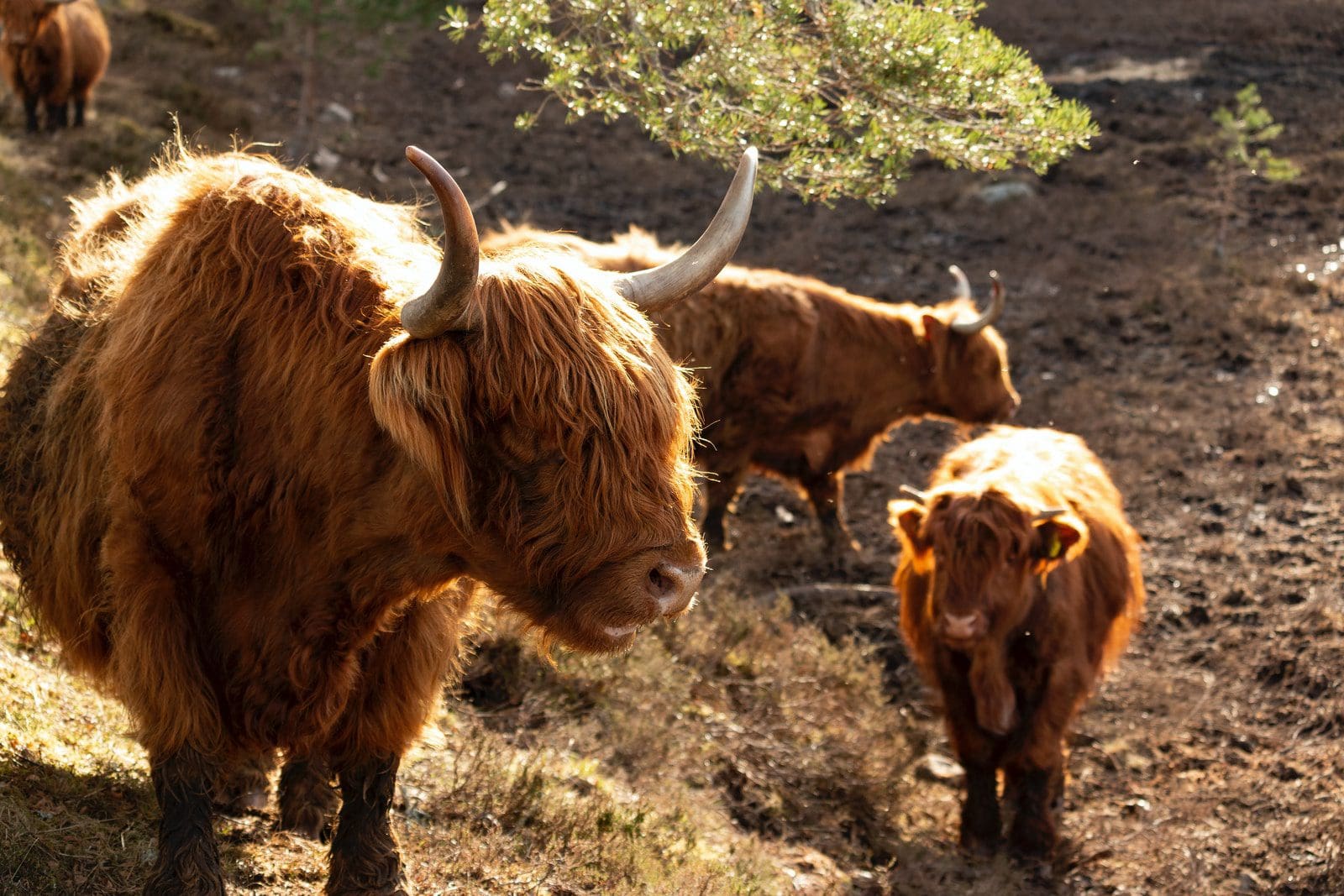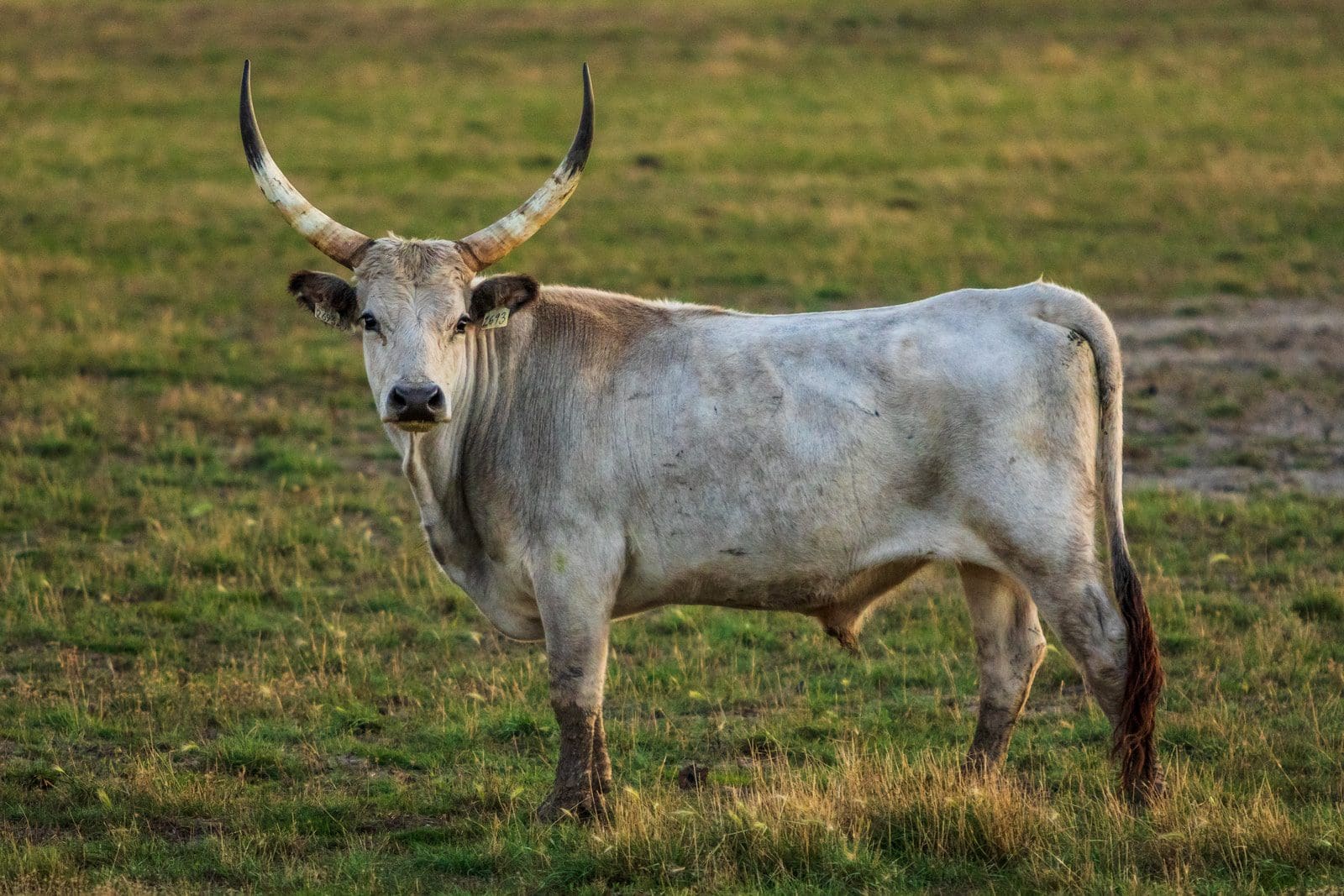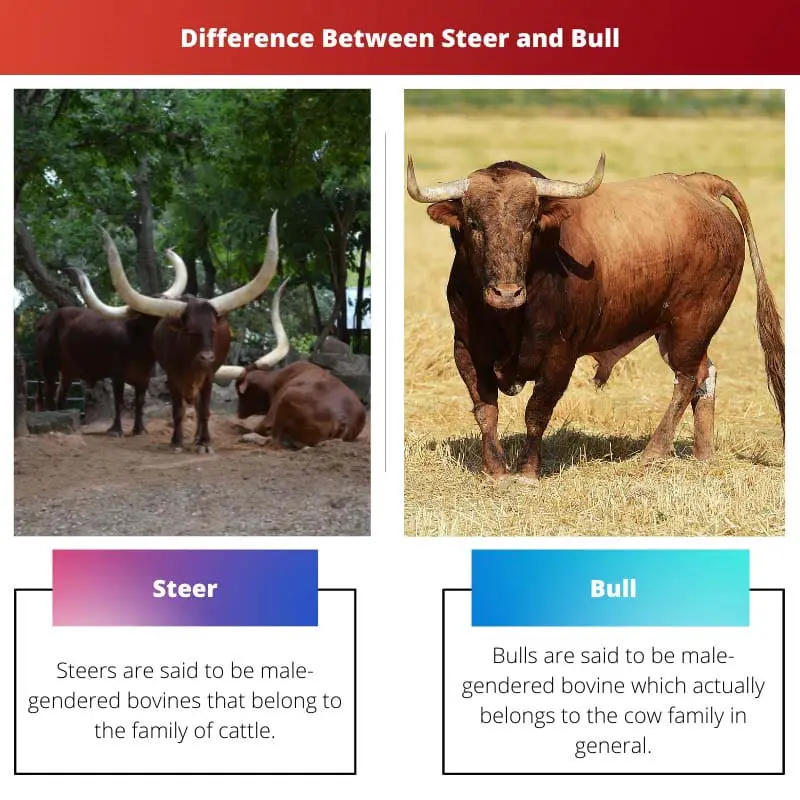A steer and a bull are animals that belong to the cattle family. But both, indeed, do have their differences in them.
Even though both these animals are male bovine, they differ in attitude with how they appear and behave with humans and other animals in their herd.
They are different in their anatomical traits.
Key Takeaways
- Steer refers to a castrated male bovine used for beef or draft purposes, whereas a bull is an uncastrated adult male bovine used mainly for breeding.
- The main physical difference between a steer and a bull is that a bull has fully developed testicles, whereas a steer does not.
- Steers are more docile and easier to handle, whereas bulls can be aggressive and difficult to handle, making them more suitable for experienced handlers.
Steer vs Bull
Bulls are bigger and more powerful than steers. Bulls aren’t castrated and can therefore reproduce. Bulls are more aggressive and irritable. While steers undergo early castration, which causes them to develop physically differently from bulls. They are easier to handle as they are quite docile.

Steers are said to be male-gendered bovines belonging to the cattle family. This animal is a bull at the initial age and stage, but after it goes through castration, it becomes a steer and is called a steer. A steer can be called a young lad of a bull when it’s not mature enough to mate or reproduce.
A bull is said to be a male-gendered bovine that actually belongs to the cow family in general. This animal is a mature one that does have the capacity to mate and reproduce as other animals do. Hence, a bull is not a castrated animal like all other cattle animals in a herd.
Comparison Table
| Parameters of comparison | Steer | Bull |
|---|---|---|
| Castration | Steers are castrated at a young age itself. | Bull is never castrated by nature. |
| Reproductive characteristics | Steers are male bovines that do not and cannot mate and reproduce. | Bull is male bovines that can do mating and can reproduce too. |
| Physical characteristics | Steer’s body does not actually develop into a muscular body like other cattle animals. | Bull’s body grows into a fully muscular body with rigid ribs. |
| Meat Content | Steers need less amount of meat content as compared to a bull. | Bulls need more amount of meat content as compared to a steer since it has to reproduce. |
| Behaviour | Since steer is castrated, there are meagre chances of a steer charging at humans and other animals of their herd. | Since bulls are not castrated, they have been observed to dominate the herd and compete with other male bovines to get female bovines which tend to be aggressive. |
What is Steer?
Steers are said to be male-gendered bovines that belong to the family of cattle. This animal is a bull at the initial age and stage, but after it goes through castration, it becomes a steer and is called a steer.
A steer can be called a young lad of a bull when it’s not mature enough to mate or reproduce. Since a steer is castrated, it has a very low chances of charging at humans and other animals in their herd.
The steer has a body that has a thick and rigidly built top having strong bones with an adequate amount of pattern in them.
The placement of its feet and legs is square, having a long, thick, and deep muscular and well-built body.
It has a deep, wide loin, a long neck, and a stout body. A steer has a deep forelimb and a small throat. This animal has a well-built rib and smooth shoulders.

What is a Bull?
Bulls are said to be male-gendered bovine, which belong to the cow family. This animal is a mature one that has the capacity to matting and reproduces as other animals do.
Hence, a bull is not a castrated animal like all other cattle animals in a herd.
Since bulls are not castrated, they have been observed to dominate the herd and compete with other male bovines to get female bovines who tend to be aggressive, which increases the rate of chances to charge at humans and other cattle animals.
Bull has a body type that has a fantastic ability to convert feed into beef. It has an amazing forager even in poor postures.
The legs of a bull are short, and they breed very often. This animal grows fast at a high maturity rate at an early age. It does not catch any diseases as compared to other cattle herds.
It has a deep chest with a rocky body that is hardcore to touch, having square-shaped rumps and legs.
They have a well-built body and appear in a square or a block shape. Bulls have muscular bodies with bones that are thick enough.
They have feet that look enormously large and thick necks that are stout. This animal also has a solid and giant head.

Main Differences Between Steer and Bull
- Bulls are animals capable of mating and reproducing, while, on the other hand, a steer isn’t capable of mating and reproducing.
- A bull is not castrated by nature, while a steer is castrated.
- A bull isn’t a docile male bovine and hence doesn’t get into fights with its animals in the herd, but on the other hand, a steer is a docile male bovine that gets into fights with animals in its herd.
- Bulls have larger bodies while, on the other hand, a steer has a smaller body compared to a bull.
- The meat content required for a bull to eat is more, while the meat content required for a steer is less than compared of a bull.

- https://link.springer.com/content/pdf/10.1007/s11033-011-0680-y.pdf
- https://onlinelibrary.wiley.com/doi/abs/10.1111/j.1365-2621.1978.tb02429.x

The content is quite intellectually stimulating, it’s refreshing to read such well-informed articles about cattle. The depth of knowledge is impressive.
I share the same sentiment, the intellectual depth of this article is truly commendable.
This post is highly enlightening, the comparison tables were significantly useful in understanding the differences between steers and bulls.
I completely agree, the comparison tables made the information easy to grasp.
The tables did a great job at simplifying the comparison between these animals.
I was happy to read a post that provides such detailed knowledge about bovines. It’s a refreshing change from regular content.
Absolutely, I feel like I’ve gained a lot of valuable information from this article.
This post is beneficial for anyone looking to understand the distinctions between a steer and a bull. It’s both educational and enlightening.
I couldn’t agree more, this article provides a comprehensive understanding of these two bovines.
I find the data provided in this post fascinating, I think it provides an accurate comparison of steers and bulls.
The tables used for comparison proved to be very helpful to understand the differences.
Absolutely, the content in this article is very enriching.
This article is very informative, I learned a lot about the differences between a steer and a bull. I appreciate the thorough comparison.
I agree, this article does a great job explaining the key differences between the two animals.
The contrast between a bull and a steer is remarkably well laid out in this article. The explanation of their anatomy is particularly engaging.
The anatomical comparison is indeed very well explained.
The detailed descriptions shed light on the distinctions between the two animals.
I appreciated the detailed explanation of the physical characteristics of steers and bulls. It’s well-written and easy to comprehend.
I completely agree, the article is very well articulated.
I found it quite intriguing, especially the detailed body descriptions.
I found the section about the behavior differences between steers and bulls particularly interesting. It’s great to see such detailed information in one place.
It’s quite insightful to learn about their behavior based on their physiological differences.
Yes, it certainly gives a clear picture of the behavior patterns of both animals.
While I’m familiar with the difference between steers and bulls, this article presents a thorough comparison that left me impressed.
This article serves as an excellent resource to fully understand the characteristics of these animals.